Biography of Max Klinger
Max Klinger was born on February 18, 1857. Accurate data about his childhood and about the artist’s family has not been preserved. It is known that in 1874 he entered the art academy in Karlsruhe, where until 1875 he studied art under the famous genre painter Karl Gussow. Then he moved to Berlin and entered the capital’s Academy of Arts.
After graduation, Max Klinger settled in Leipzig, traveled frequently and brought new experiences from each trip. So, during his stay in Brussels in 1879, he worked with the Belgian portrait painter Emile Charles Wauters. The painter devoted 1883-1886 to Paris, where he studied the works of old masters exhibited in the Louvre, copied the works of Francisco Goya and Honoré Daumier. The period from 1888 to 1893 Max Klinger spent in Rome, where he became friends with Arnold Böcklin (Arnold Böcklin) and “infected” from him the ideas of symbolism.
The work of Max Klinger can be roughly divided into several stages – in the early years he was under the influence of romantic historicism, and painted a large-scale painting “The Death of Caesar.” Then the artist worked in a mixed style, a kind of mix of “conservative” modernity, academism and fantasy, vivid examples of which can be called “The Judgment of Paris” and “The Crucifixion”.
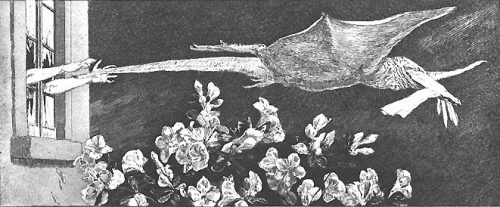 kidnapping
kidnapping
Klinger devoted a significant part of his life to engraving
He completely dropped conventions and created several memorable series, one of which is dedicated to Christianity. Since the beginning of the 20th century, Max Klinger has been closely engaged in sculpture, using alabaster, ivory, marble, bronze and gold in his work. He creates small busts, statues, large-scale monuments.
Max Klinger showed himself as a multifaceted creative person who sees the beauty of nature in all its manifestations. An excellent draftsman, sculptor and engraver, he was also an excellent craftsman in the processing of precious stones and metal, composed music and wrote a book on art called Painting and Drawing (Malerei und Zeichnung, 1891).
The genius passed away on July 5, 1920, and his old house in Leipzig was converted into a museum that receives visitors from all over the world today.
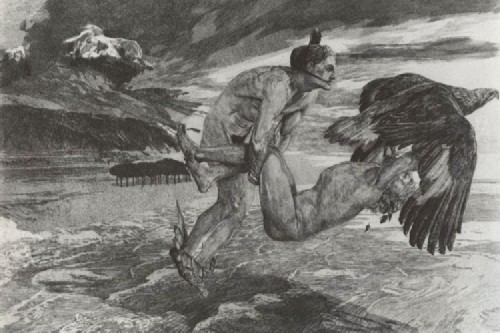 Abduction of Prometheus 1894
Abduction of Prometheus 1894
The most famous paintings, prints and sculptures by Max Klinger
Paintings and sculptures by Max Klinger are the decoration of any collection focused on symbolism and modernity. The talented painter and sculptor raised in his work plots from mythology, classical and modern literature, actively used allegory, inhabited his works with fantastic creatures. Among the most striking works of Max Klinger:
- The Death of Caesar (1879) is Klinger’s first serious painting to be recognized by the public and central to the history of German art as an example of historical symbolism.
- Paraphrases to a Found Glove (1881) is a cycle of engravings about the insanity of a young man who fell in love with a woman’s glove. The series in the form of ink drawings was created in 1878, when Max Klinger turned 21, and was first presented to the public at the Berliner Kunstverein gallery.
- “Blue Hour” (1886-1890) – a work that the master populated with mermaids, bears a resemblance to the surreal paintings of Pablo Picasso.
- Salome (1893) is a mythological subject in the nude genre. The work is kept in the Leipzig Museum of Fine Arts.
- “Christ on Olympus” (1897) – the triptych uses Klinger’s favorite theme – religious mythology. The work is kept in the Gallery of Austrian Painting.
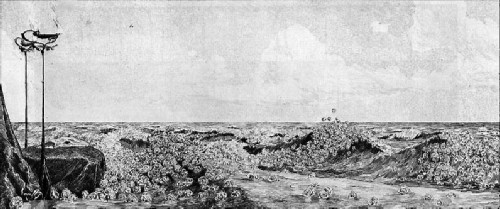 Huldigung
Huldigung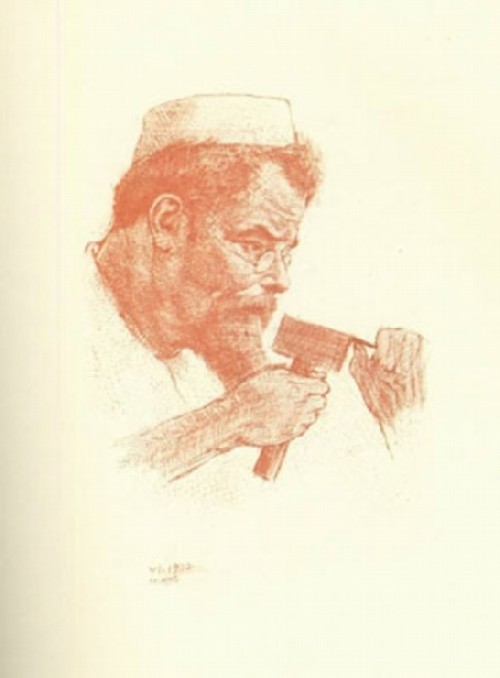 Portrait of Max Klinger by Emil Orlik. 1902
Portrait of Max Klinger by Emil Orlik. 1902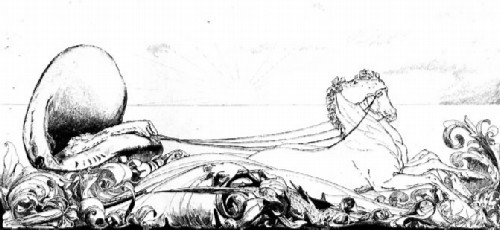 Triumph
Triumph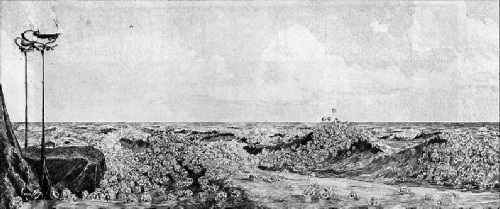 Worship
Worship
Works Inspired by Darwinism

Similar to the philosophy of Friedrich Nietzsche, the evolutionary theory of Charles Darwin played an important role in Max Klinger’s art and worldview. Klinger’s interest in Darwin’s works began at the age of eighteen. His graphic art probes the mysteries of human behavior and psychology, particularly those affected by biological drives. Some of his earliest graphic art from the mid-1870s documents Darwin’s theory of the struggle for existence and the struggle for mates.
Klinger’s sketchbook from 1874-77 contains scenes of violence and sexuality, many of which became sources for his later prints. Works like the Goyaesque Fox Hunt, with animals pursued by brutes, or Buzzards with a Dead Hare, document an incident observed in the backyard of his parent’s Leipzig home. The dark side of nature’s food chain is grimly depicted in Siesta I, from his first published graphic series, Etched Sketches. In it, two lobsters enjoy an after-dinner siesta next to the carcass of a fish they have consumed.
Works Inspired by Darwinism

Similar to the philosophy of Friedrich Nietzsche, the evolutionary theory of Charles Darwin played an important role in Max Klinger’s art and worldview. Klinger’s interest in Darwin’s works began at the age of eighteen. His graphic art probes the mysteries of human behavior and psychology, particularly those affected by biological drives. Some of his earliest graphic art from the mid-1870s documents Darwin’s theory of the struggle for existence and the struggle for mates.
Klinger’s sketchbook from 1874-77 contains scenes of violence and sexuality, many of which became sources for his later prints. Works like the Goyaesque Fox Hunt, with animals pursued by brutes, or Buzzards with a Dead Hare, document an incident observed in the backyard of his parent’s Leipzig home. The dark side of nature’s food chain is grimly depicted in Siesta I, from his first published graphic series, Etched Sketches. In it, two lobsters enjoy an after-dinner siesta next to the carcass of a fish they have consumed.
Приложения
Список используемой литературы
: документ, использованный в качестве источника для этой статьи.
- «Клингер, Макс», в: Ганс Х. Хофштеттер, Югендстиль и модерн. Графические работы , Париж, Альбин Мишель, 1985, стр. 153 .
- «Клингер, Макс», в: Жан Кассу (направление), Энциклопедия символизма , Париж, Somogy, 1988, с. 93 .
- Мари-Жанна Гейер и Тьерри Лапс (режиссура), Макс Клингер: театр странного. Les suites gravées 1879-1915 , каталог выставки, Страсбург, Музеи города Страсбурга, 2012, ( ISBN ) .
внешние ссылки
- Примечания в общих словарях или энциклопедиях :
- Ресурсы изобразительного искусства :
- Ресурсы, связанные с музыкой :
-
Авторитетные записи :
- ( )
8. A Love Series
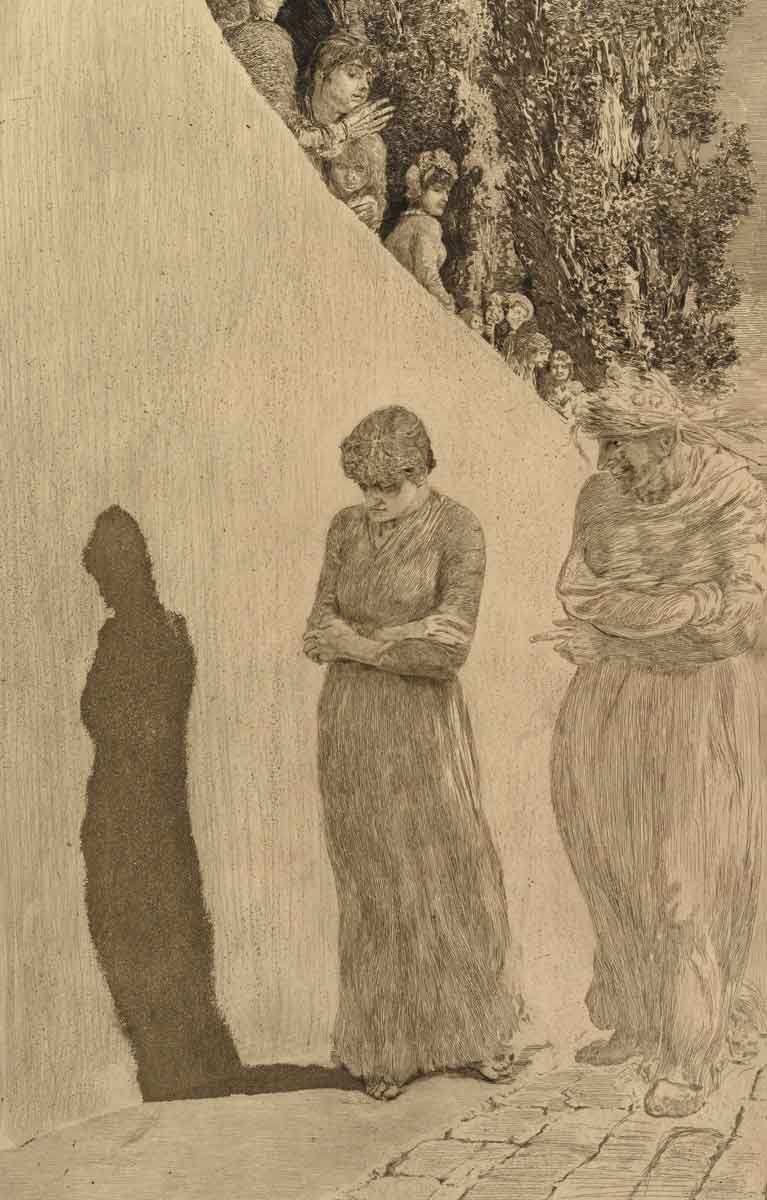
Max Klinger’s art also explores in great depth the themes fit for the contemporary Symbolist movement. He was acquainted with Arnold Böcklin in 1887, considered by art historians one of the most important representatives of German Symbolism. That same year, Klinger took up Böcklin’s way of presenting a narrative.
While living in Rome, Klinger produced another print series based on social criticism titled A Love. Through the etchings, we follow a modern Berlin woman pursued by a suitor. Over the course of the series, he seduces, impregnates, and abandons her, leaving her to die in childbirth. We can see Böcklin’s influence through the abandonment of naturalism in representing a narrative. In A Love, the narrative is rather evoked, with examples being a woman being guided by an allegorical figure of Shame toward Death. This shadowy figure snatches her infant in the last scene.
Judgment of Paris
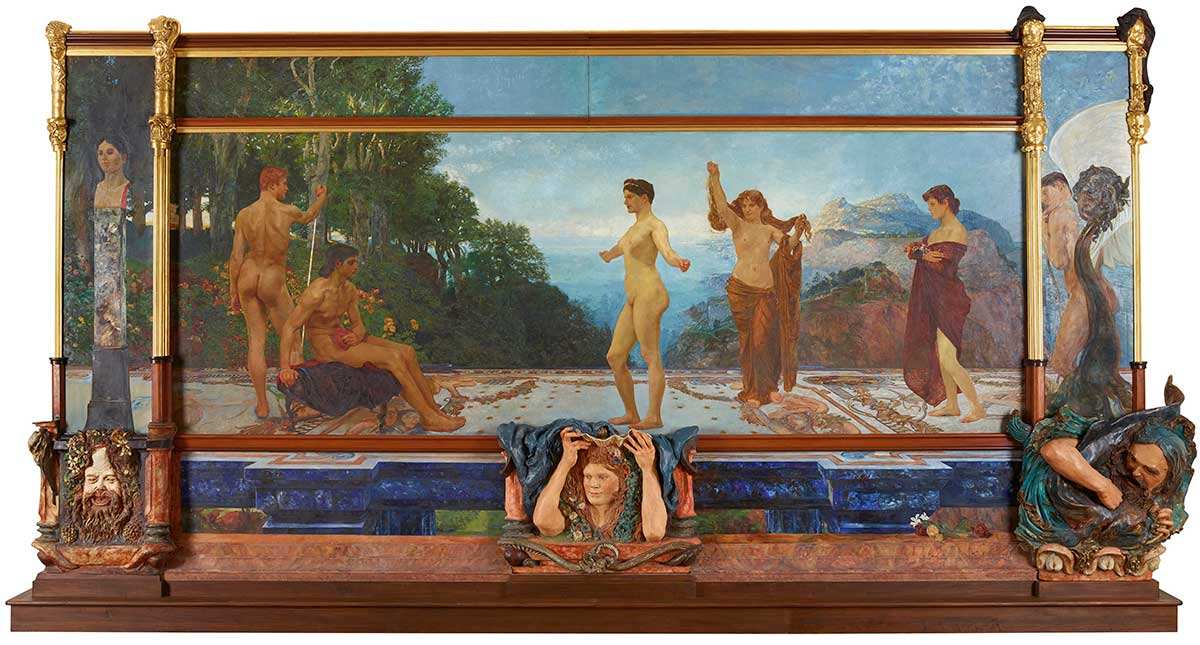
The Judgment of Paris is a common theme in art history, wherein an artist depicts an important episode of the Trojan War. The Trojan prince Paris sits opposite the three goddesses: Aphrodite, Athena, and Hera, judging which one is the most beautiful. The messenger of the gods, Hermes, seems disinterested and looks off into the distance.
The painting was exhibited for the first time in 1887 in the State Exhibition Building at Lehrter Bahnof in Berlin. Both the audience and critics reacted with incomprehension and rejection. For a theme that is typically classical and common, it still failed to meet the standards of the 19th-century art establishment. Klinger denies the female figures any idealism and reverses the ideas of 19th-century gender roles. Sitting next to Hermes, who doesn’t have any typical iconography elements, Paris seems embarrassed more than anything. The liberty with which the goddesses presented their charms to Paris shocked the public.
Judgment of Paris

The Judgment of Paris is a common theme in art history, wherein an artist depicts an important episode of the Trojan War. The Trojan prince Paris sits opposite the three goddesses: Aphrodite, Athena, and Hera, judging which one is the most beautiful. The messenger of the gods, Hermes, seems disinterested and looks off into the distance.
The painting was exhibited for the first time in 1887 in the State Exhibition Building at Lehrter Bahnof in Berlin. Both the audience and critics reacted with incomprehension and rejection. For a theme that is typically classical and common, it still failed to meet the standards of the 19th-century art establishment. Klinger denies the female figures any idealism and reverses the ideas of 19th-century gender roles. Sitting next to Hermes, who doesn’t have any typical iconography elements, Paris seems embarrassed more than anything. The liberty with which the goddesses presented their charms to Paris shocked the public.
Death & Legacy of Max Klinger
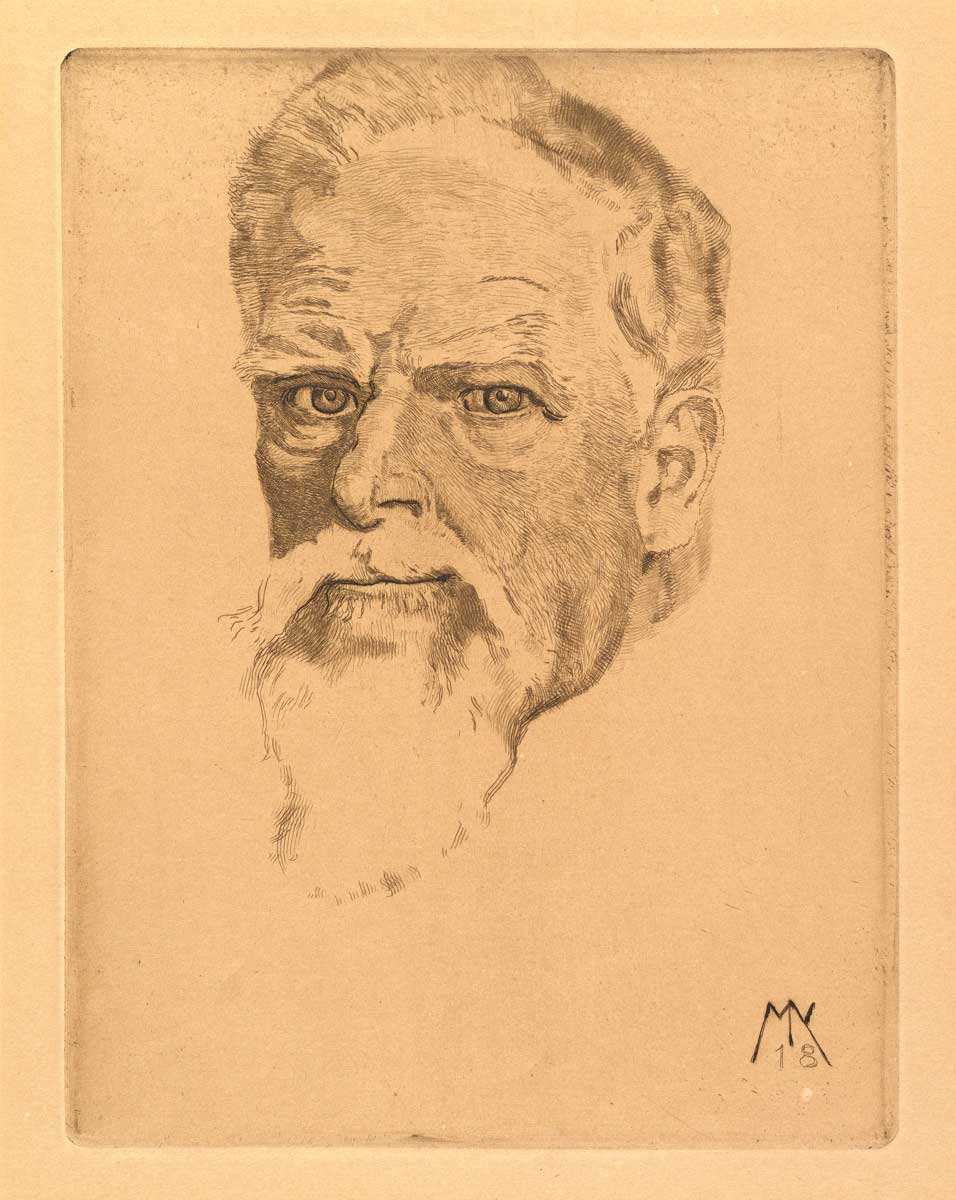
Max Klinger passed away on 5th July 1920, at the age of 63, in Grossjena, near the German city of Naumburg. Today, he is chiefly remembered for a stylistic blend of Jugendstil and Symbolism through which he expressed his dreamlike, gruesome, and grotesque visions.
Even before his passing, Klinger exuded a strong influence over young graphic artists in Germany, such as Käthe Kollwitz. Thanks to him, these young artists saw the print cycle as a powerful new means of narrative expression and formal experimentation.
Despite the unusual nature of his choice of subjects, Klinger’s art reveals to us a vision of 19th-century modern life. His combination of dark themes and the stylistic aspects of print was taken up by the 20th-century Surrealists, who admired his exploration of the uncanny. The German Expressionists later revived and advanced the graphic cycle as part of their Germanic heritage and considered Klinger’s art as integral to their national tradition.
The Blue Hour
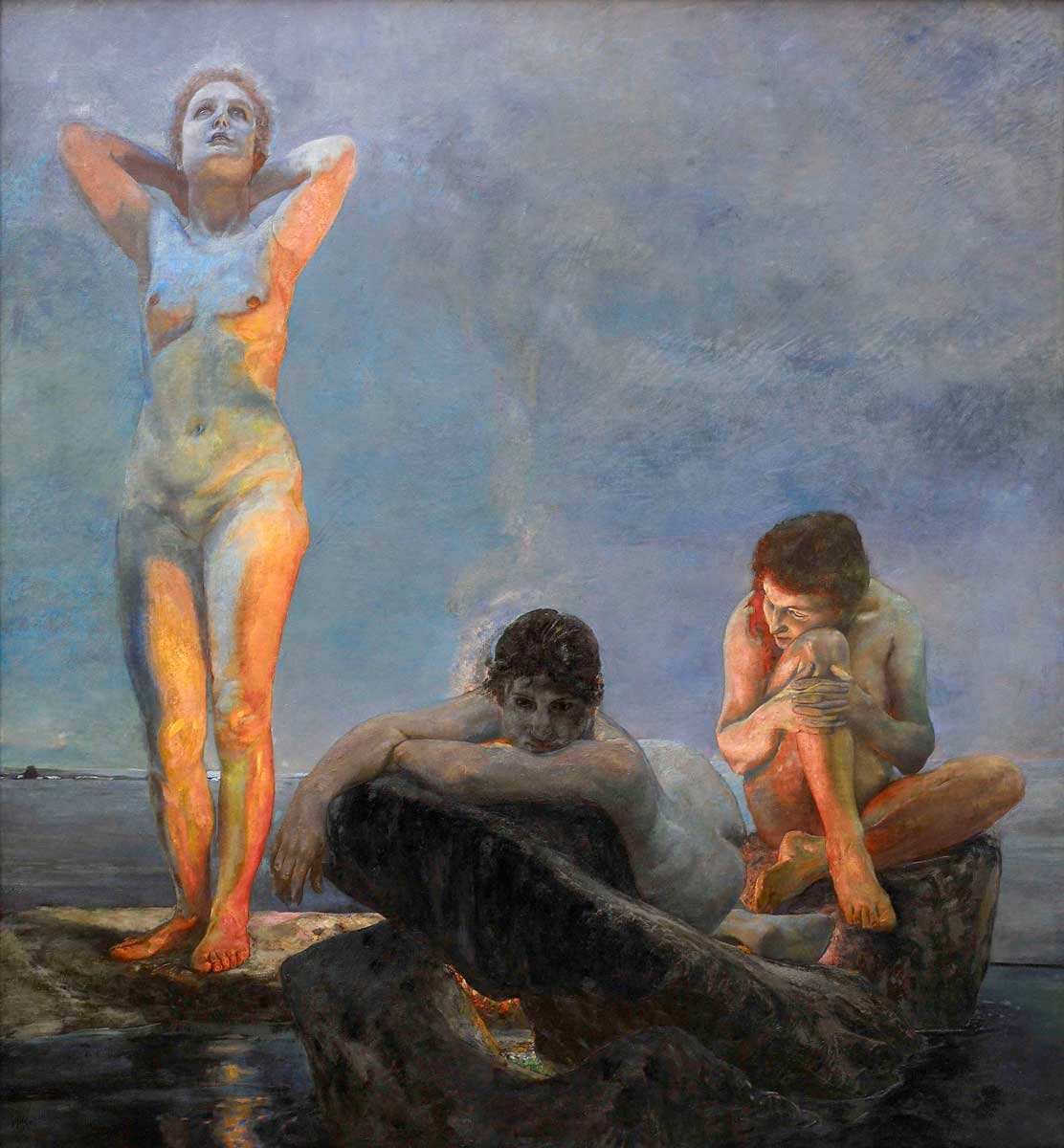
The Blue Hour, painted in 1890, is one of Max Klinger’s best-known paintings and a crucial element in understanding German Symbolism. The painting is located at the Museum of Fine Arts in Leipzig.
Symbolism greatly influenced Max Klinger’s art, including all the various media in which he was proficient. The Blue Hour shows how Klinger communicated with the contemporary art circles and their Symbolistic ideas. To Symbolist painters, light and color were merged to become a means of expression in their own right, divorced from the subject of the image. Thanks to this, Symbolist imagery appeared to elude normal perception. In order to give the image a particular mood and ambiance, the palette of Max Klinger’s Blue Hour is diminished. To Symbolists, the color blue emphasizes loneliness, melancholy, and longing. A hidden fire warms the scene and casts a flickering light over the women’s bodies, contrasting the blue color and evoking a sense of undefinable warmth and passion.
2. Portrait Bust of Friedrich Nietzsche
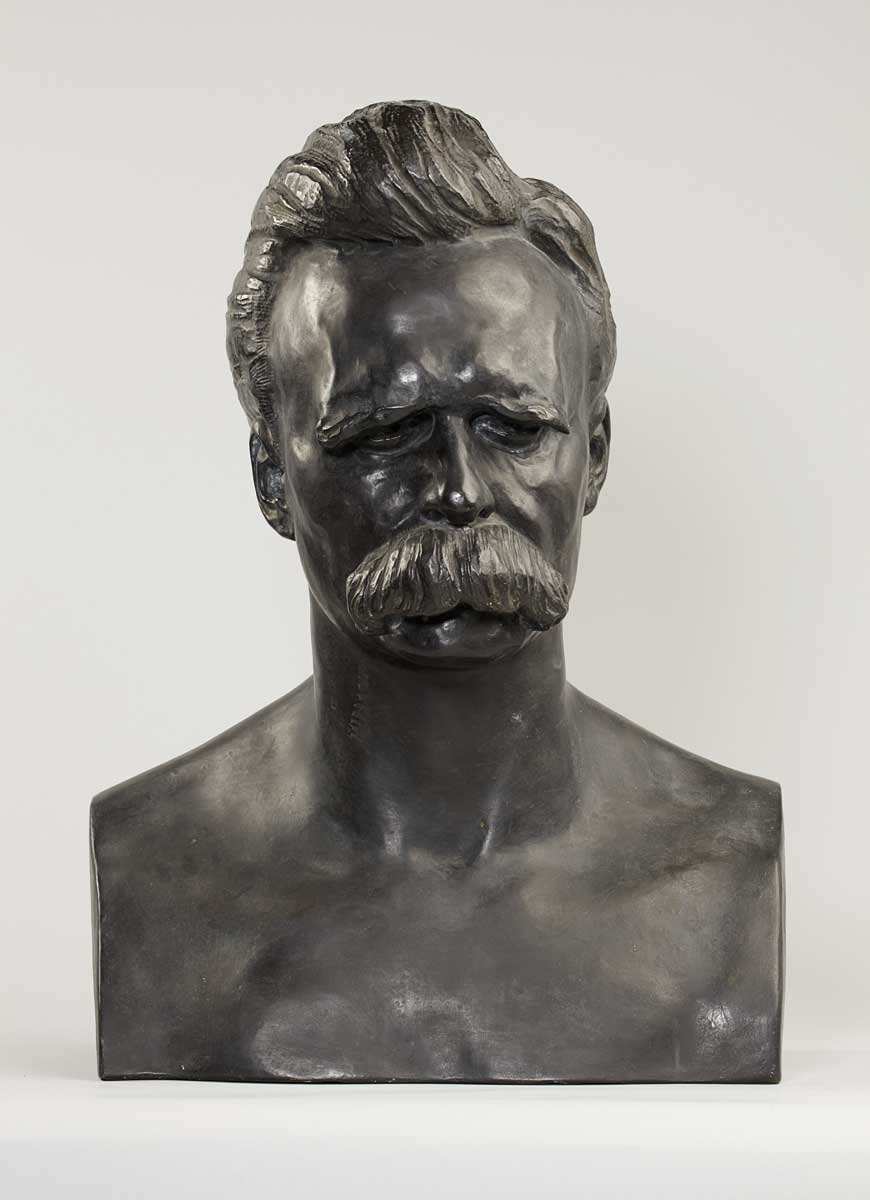
Get the latest articles delivered to your inbox
Sign up to our Free Weekly Newsletter
The philosopher Friedrich Nietzsche greatly impacted Max Klinger’s art and his personal worldview. It could be said the artist was an admirer of the philosopher and even had live sessions with him for a bust series. After Nietzsche’s death, he was asked to make a death mask, but he couldn’t make the commission since he was living in Paris at the time. Though the philosopher’s sister, the artist Elisabeth Förster-Nietzsche, ended up doing the bust, it was requested that Klinger rework the mask. Klinger describes the mask in one of his letters: “A face of such boundless, inexpressible agony of the soul, without distortion, without wrinkles, only the greatest depth of painful resignation.”
This bust of Friedrich Nietzsche is based on a study on which Klinger worked, circa 1902, after the philosopher’s death. It shows a brooding face whose gaze is pointed inward. The bust shows a “knowing” thinker, not a speaker. It is one of the most potent images of Nietzsche and largely contributes to the ideas of the philosopher’s appearance.
2. Portrait Bust of Friedrich Nietzsche

Get the latest articles delivered to your inbox
Sign up to our Free Weekly Newsletter
The philosopher Friedrich Nietzsche greatly impacted Max Klinger’s art and his personal worldview. It could be said the artist was an admirer of the philosopher and even had live sessions with him for a bust series. After Nietzsche’s death, he was asked to make a death mask, but he couldn’t make the commission since he was living in Paris at the time. Though the philosopher’s sister, the artist Elisabeth Förster-Nietzsche, ended up doing the bust, it was requested that Klinger rework the mask. Klinger describes the mask in one of his letters: “A face of such boundless, inexpressible agony of the soul, without distortion, without wrinkles, only the greatest depth of painful resignation.”
This bust of Friedrich Nietzsche is based on a study on which Klinger worked, circa 1902, after the philosopher’s death. It shows a brooding face whose gaze is pointed inward. The bust shows a “knowing” thinker, not a speaker. It is one of the most potent images of Nietzsche and largely contributes to the ideas of the philosopher’s appearance.
Public Recognition

Max Klinger’s public recognition came in 1878 with his debut at the 52nd Academy Exhibition in Berlin. His series of pen-and-ink drawings, Paraphrase upon the Finding of a Glove, caused an outburst of indignation but nonetheless showed the young artist’s originality and Symbolist tendencies.
Three years later, in 1881, Klinger was moving towards being an independent artist, opening his studio in Berlin and being accepted as a member of the Berlin Artist’s Association. In 1883, Klinger received his first large commission. Julius Albers, a 19th-century industrialist, hired him for the decoration of the vestibule of his villa.
Max Klinger grew ever more successful in the following decades, becoming a member of the Munich Academy. The Dresden Paintings Gallery became the first museum to buy one of his paintings (Pieta), and he was appointed professor at the Royal Academy of the Graphic Arts in Leipzig.
Parallel to these traditional and prestigious positions in the art world, Klinger became a member of the newly founded Vienna Secession. This indicates that Klinger played a seminal role in introducing modern art to Germany. He promoted artistic dialogue and supported young artists by founding the Villa Romana and the Association of Annual Leipzig Exhibitions. He purchased a villa in Florence, to which he invited outstandingly gifted artists to live cost-free for up to a year and get to know Medieval and Renaissance art.
Биография
Родившийся в Лейпциге из богатой семьи, он проявляет себя как художник-эклектик, одаренный рисованием и живописью , он посещал Grossherzogliche Badische Kunstschule в Карлсруэ .
Постоянная тенденция отказаться от академического преподавания привела его в году в Берлин , вслед за своим учителем Карлом Гусовым , где он изучал, среди прочего, теории Дарвина и французскую литературу
Он завершает учебу в Берлинской академии в 1877 году и в то же время развивает свой интерес к рисункам пером и тушью, добившись в следующем году важного успеха на 52-й выставке местной Королевской академии.. Цикл рисунков Парафраз об открытии перчатки приведет к тому, что ее по достоинству оценят в Дании и Норвегии
В этот период он начинает изучение графических техник и начинает офортировать свои рисунки. После пребывания в Брюсселе он переехал в Мюнхен в 1880 году. Серии Schizzi etching и Eva and the future , благодаря интересу
Кристиана Крога , будут выставлены в Cristiania ( Осло с года), оказывая влияние на норвежскую богему, к которой принадлежал молодой Эдвард Мунк. Вернувшись в Берлин в году, после некоторого пребывания в Париже, где он будет изучать, в частности, работы Гюстава Доре , Франсиско Гойи и Пьера Пюви де Шаванна , начиная с года он также начнет интересоваться цветной скульптурой и продюсировать ( ) первые эскизы для статуи Бетховена .
Цикл рисунков Парафраз об открытии перчатки приведет к тому, что ее по достоинству оценят в Дании и Норвегии . В этот период он начинает изучение графических техник и начинает офортировать свои рисунки. После пребывания в Брюсселе он переехал в Мюнхен в 1880 году . Серии Schizzi etching и Eva and the future , благодаря интересу
Кристиана Крога , будут выставлены в Cristiania ( Осло с года), оказывая влияние на норвежскую богему, к которой принадлежал молодой Эдвард Мунк . Вернувшись в Берлин в году, после некоторого пребывания в Париже, где он будет изучать, в частности, работы Гюстава Доре , Франсиско Гойи и Пьера Пюви де Шаванна , начиная с года он также начнет интересоваться цветной скульптурой и продюсировать ( ) первые эскизы для статуи Бетховена .
В году он был в Италии , интересовался каррарским мрамором . В году он познакомился с Арнольдом Беклином и Юлиусом Фогелем , директором Museum der bildenden Künste в Лейпциге. С года он находится в Риме и предпринимает несколько ознакомительных поездок на Сицилию . В издал Студию живописи и рисунка . С февраля года он войдет в состав группы « Эльф » , которая, реорганизованная Максом Либерманом , после принудительного закрытия ретроспективной выставки Мунка даст начало Берлинскому сецессиону . В 1894 году он будет в Греции в поисках полихромного мрамора и узнает о следах цвета, недавно обнаруженных в древнегреческих скульптурах Афинского Акрополя . С года он был членом Венского сецессиона . Он знакомится с венской писательницей Эльзой Асениевой , которая станет его моделью и партнершей. С года он живет в Париже , где работает над бронзовым троном статуи Бетховена, которая после завершения будет выставлена на 14-й выставке Венской секции ( ).
В году он купил римскую виллу во Флоренции, учредив премию для молодых немецких художников, которая существует до сих пор. В году он находится в Испании .
Ловис Коринт , ныне знаменитый, удостоившийся многих наград, в том числе почетных степеней в области медицины и философии, посвятил свою лекцию о немецкой живописи «…самому немецкому из художников, Максу Клингеру» ( ).
В 1915 году он опубликовал последнюю из своей серии офортов под названием «Палатка в Лейпциге» . В году, уже тяжело больной, он женился на Гертруде Бок , новой модели с 1910 года, которую он назначает своей универсальной наследницей.
Он умер 4 июля 1920 года в Гросьене , недалеко от Наумбурга , в своем маленьком доме с виноградником, купленном в 1903 году .
Три замечательные гравюры, Kämpfende Centauren (Центавр в лотте) и Bergsturz (Оползень) 1881 года вместе с Кюнстлером (Гениальный художник) 1904 года, можно увидеть в Современном искусстве Монтекатини с 5 июня по 29 августа 2021 года в рамках выставки «Дизеньо». в знак «.
8. A Love Series

Max Klinger’s art also explores in great depth the themes fit for the contemporary Symbolist movement. He was acquainted with Arnold Böcklin in 1887, considered by art historians one of the most important representatives of German Symbolism. That same year, Klinger took up Böcklin’s way of presenting a narrative.
While living in Rome, Klinger produced another print series based on social criticism titled A Love. Through the etchings, we follow a modern Berlin woman pursued by a suitor. Over the course of the series, he seduces, impregnates, and abandons her, leaving her to die in childbirth. We can see Böcklin’s influence through the abandonment of naturalism in representing a narrative. In A Love, the narrative is rather evoked, with examples being a woman being guided by an allegorical figure of Shame toward Death. This shadowy figure snatches her infant in the last scene.
Биография[править | править код]
Учился рисованию в Карлсруэ у жанрового художника Карла Гуссова, тогда же изготовил по заказу серию рисунков с античных статуй. Переехав в Берлин, подпал под влияние историзированного стиля Менцеля. Первые художественные работы в живописи и графике относятся к 1878 г. В 1879 г. рисует полотно «Смерть Цезаря» (Лейпциг, Музей изобразительного искусства), ставшее центральным в развитии немецкого исторического символизма.
Большое значение в творчестве Клингера занимала графика, в которой он был виртуозным мастером и которой он в своей книге «Живопись и рисование», вышедшей в 1891 году, придаёт особое, самостоятельное значение в отображении внешнего мира. При этом Клингер считал, что графике свойственно передавать демонически-тёмные аспекты жизни, адекватно выражаемые в линейной и контрастной манере, что позволяет рассматривать Клингера как одного из предтеч сюрреалистов. Изображение «циклов» действия с изображением фантастически-символистских воображаемых реальностей сам Клингер сравнивал с музыкальным произведением («опусом»). Сама же живопись оставалась для художника реалистически-позитивным средством выражения. Под особенным влиянием Клингера находился Пюви де Шаванн, создавший в Париже серию аллегорических, монументальных произведений настенной живописи. Своей целью в искусстве Клингер видел объединение живописи, пластики и архитектуры. Написанные Клингером религиозные картины показывают влияние на мастера итальянского Ренессанса.
Max Klinger
Leipzig
1857 —
Großjena
1920
Max Klinger was one of the last great «artist princes» of the late 19th and early 20th centuries. In 1874 Klinger began his studies at the Grand Ducal Baden Art School in Karlsruhe, continuing from 1875 at the Royal Academy of Art in Berlin under Karl Gussow. Klinger completed his studies with the evaluation «exceptional» and a silver medal. At that time Klinger’s role model as an artist was Adolph Menzel. In 1878 Klinger showed work for the first time publicly at the 52nd Academy Exhibition in Berlin. The following year Max Klinger became a pupil of Emile Charles Wauters’ in Brussels. In 1880 he painted the «Eva und die Zukunft (Opus III)» cycle. A year later Max Klinger opened a studio in Berlin, where he soon became a member of the Berlin Artists’ Association. In 1883 Klinger received his first large commission: to decorate the vestibule of Julius Albers’ villa. That same year Klinger acquired a Paris studio and devoted himself to studying the work of Goya and Daumier in the Louvre but he was most attracted by the work of Puvis de Chavannes. On his return to Berlin, Klinger met Arnold Böcklin in 1887. Numerous trips to Italy, Brussels, Paris, Greece, London and Munich shaped the years that followed. In 1893 Klinger returned to his native Leipzig. Max Klinger grew successful, becoming a member of the Munich Academy. The Dresden Paintings Gallery became the first museum to buy one of his pictures («Pietà») and he was appointed professor at the Royal Academy of the Graphic Arts in Leipyig and made a member of the newly founded Vienna Secession. The idea of the «Gesamtkunstwerk» (total work of art) informed Klinger’s aesthetic preoccupation with literature, sculpture, painting and drawing as well as his interest in music. The graphic arts also figure prominently in the work of this versatile and extremely prolific artist. Max Klinger promoted the artistic dialogue of his day by founding the Villa Romana and the Association of Annual Leipzig Exhibitions. The numerous distinctions Klinger was awarded (being made a Knight of the Pour le mérite order, an honorary member of the Stockholm Academy, etc) not only attest to his success but also indicate the seminal role Klinger played in introducing modern art to Germany. The work, stylistically a blend of Jugendstil and Symbolism, for which Klinger is chiefly remembered today includes dreamlike cycles of prints and sculpture, highly controversial during his lifetime, such as the «Beethoven» monument.
Max KlingerIntermezzi
1,110 $Details
Renée SintenisGroße Daphne
222,000 $Details
Max LiebermannDie Colomierstraße in Wannsee
222,000 $Details
Erich HeckelFrauenbildnis (Bildnis Siddi Heckel)
55,500 $Details
Käthe KollwitzIm Profil
44,400 $Details
Lotte LasersteinPorträt Katharina und Anne-Marie Riedl
44,400 $Details
Maurice UtrilloLe Moulin de la Galette
33,300 $Details
Karl HoferMann und Frau
33,300 $Details
Symbolism & Dream-like Visions
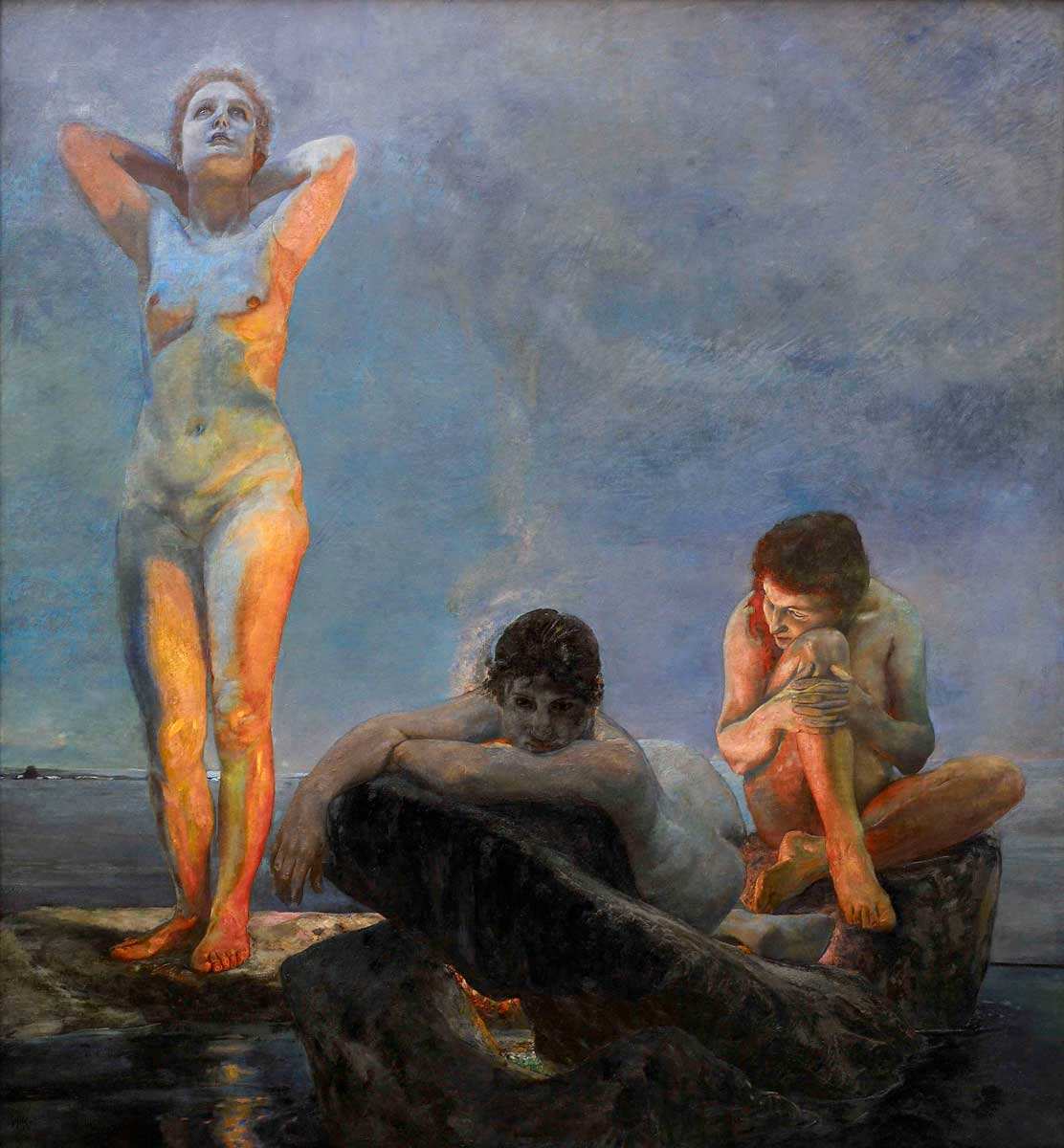
Max Klinger’s art has been recognized by art historians as fundamental for understanding Symbolist art in Germany. The painting Blue Hour shows the Symbolist treatment of light and color, in which imagery seems to elude the normal, everyday perception. The reduced palette infuses the image with a certain mood or atmosphere. In Symbolist visual language, the color blue became a symbol of loneliness, melancholy, or vague yearning. The pervasive cool atmosphere, together with a warming fire that casts a flickering light over the women’s bodies, evokes a sense of passion.
From his earliest works, as shown by the Paraphrase on the Finding of a Glove, Klinger’s art carries the viewer’s imagination out of the familiar into the world of indeterminate. Throughout the series, the viewer is carried from an everyday event to a series of wish-dreams and nightmares.
Seen in this light, Klinger’s print series precedes but is related to the works of Sigmund Freud and his Interpretation of Dreams, published in 1900. Freud’s writings finally codified what Klinger’s, and more generally Symbolist works had been visualizing for decades. The psychoanalyst writes: “With the manifold meaning of symbols, dreams combine a tendency to admit of over-interpretations, to represent, in a single content, diverse and often by nature very divergent thought formations and wishful impulses.”
Основные работы
Фэнтези Брамса
Кусс — Поцелуй (1903)
- : Люди на прогулке (картина, Берлин, Национальная галерея); Советы для конкурса на тему ‘Христос’ (рисунок, Берлин, Купферстичкабинет); Парафраз о находке перчатки (рисунки пером, Гамбург, частная коллекция).
- : Смерть Цезаря (картина, Лейпциг, Museum der bildenden Künste); Офортные зарисовки и спасения жертв Овидия (гравюры).
-
: Ева и будущее и Амур и Психея
Венера показывает Психею Купидону (op.V)
(цикл гравюр).
- — : Интермецци (цикл гравюр).
- — : отделка и отделка виллы Альберс (Берлин-Штеглиц); Драмы и Una vita (циклы офортов); Юноша (Адам) (скульптура, Берлин, Национальная галерея).
- — : эскизы к статуе Бетховена.
- : Суд Парижа (картина, Вена, Австрийская галерея).
- — : Синий час и распятие Христа (картины, Лейпциг, Museum der bildenden Künste); Пьета (ранее находилась в Галерее драгоценностей в Дрездене, потеряна в последней войне); Смерти. Часть первая (цикл гравюр).
- : Malerei und Zeichnung ( Живопись и рисунок ) (эссе по теории искусства). «Die Kreuzigung Christi» «Распятие Христа» (картина сцены Голгофы, большой скандал в Дрездене 1983 г.).
- : Новая Саломея (скульптура из полихромного мрамора и янтаря, Лейпциг, Museum der bildenden Künste).
- : Брамсфантазия (цикл офортов).
- : Кассандра (скульптура из различных видов мрамора и бронзы, Лейпциг, Museum der bildenden Künste); Проектирование и строительство дома-студии в Лейпциге, Karl-Heine Strasse 6 (частично разрушен в прошедшую войну и позже снесен).
- : Эллада (роспись в главном зале Лейпцигского университета, разрушенная во время последней войны); живописное украшение лестницы Museum der bildenden Künste на площади Аугустусплац в Лейпциге (разрушено в 1943 г.).
- — : Христос на Олимпе (картина начата в Риме в 1889, Вена, Австрийская галерея); Купальщица (скульптура, Лейпциг, Museum der bildenden Künste); Амфитрита (скульптура, Берлин, Национальная галерея); Смерти. Вторая часть (цикл гравюр).
- 1900–1902 : Бетховен ( скульптура из мрамора и бронзы, Лейпциг, Museum der bildenden Künste, южная сторона, спроектированная самим Клингером).
- : Кусс (офорт)
- : Палатка (цикл офортов).
- : Работа, здоровье, красота (фреска, ратуша Хемница).
The Blue Hour

The Blue Hour, painted in 1890, is one of Max Klinger’s best-known paintings and a crucial element in understanding German Symbolism. The painting is located at the Museum of Fine Arts in Leipzig.
Symbolism greatly influenced Max Klinger’s art, including all the various media in which he was proficient. The Blue Hour shows how Klinger communicated with the contemporary art circles and their Symbolistic ideas. To Symbolist painters, light and color were merged to become a means of expression in their own right, divorced from the subject of the image. Thanks to this, Symbolist imagery appeared to elude normal perception. In order to give the image a particular mood and ambiance, the palette of Max Klinger’s Blue Hour is diminished. To Symbolists, the color blue emphasizes loneliness, melancholy, and longing. A hidden fire warms the scene and casts a flickering light over the women’s bodies, contrasting the blue color and evoking a sense of undefinable warmth and passion.
Литература[править | править код]
- Власов В. Г. Клингер Макс // Стили в искусстве : Архитектура, графика. Декоративно-прикладное искусство. Живопись, скульптура : словарь : в 3 т. / В. Г. Власов. — СПб. : Кольна, 1996. — Т. 2 : Словарь имён : А—Л. — С. 420. — 543 с., л. ил. : ил. — ISBN 5-88737-005-X. — OCLC .
- Камчатова А. В., Котломанов А. О., Кроллау Н. Е. Германия. Англия. XV–XIX века : биографический словарь / А. В. Камчатова, А. О. Котломанов, Н. Е. Кроллау. — СПб. : Азбука-Классика, 2008. — С. 37, 38, 39, 102–106. — 480 с. : ил., цв. ил. — (Художники Западной Европы). — ISBN 978-5-91181-907-1.
- Die Welt der Malerei Köln, 1990
- M.Gibson: Symbolismus Köln, 2006























